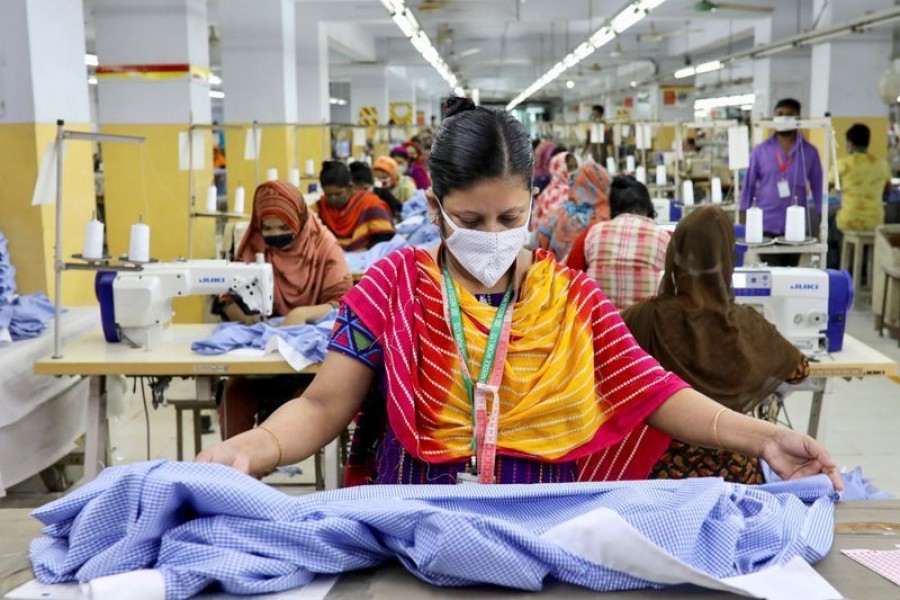That Bangladesh's apparel products fetch poor price from overseas buyers has been a much talked-about issue for long. Sometimes this was attributed to the very low segment of products that buyers buy in bulk from Bangladesh. But the reality is not so. It has been found from market research that price variation occurs, disfavouring Bangladeshi exporters, in the same product segments where competing exporters from other countries are offered higher prices.
This has been pointed out in a recent study report prepared by the International Trade Centre (ITC). The report titled 'Garment Costing Guide for small firms in value chains' said that retailers and brands should pay their suppliers a fair free-on-board (FOB) price since they are often paying the prices that are below the factory costs. Of the supplying countries mentioned in the report, Bangladesh alongside Cambodia and Pakistan are receiving prices far below the world average prices, while Vietnam, Indonesia, Turkey and Mexico are given higher than that of the global average.
The findings relate to the FOB prices of 10 most important apparel items of Bangladesh exported in 2020 vis-à-vis those of the 10 biggest competitors of each product segment. The most striking aspect of the price variation, according to the report, is that Bangladeshi exporters are offered prices that are 32 per cent to 83 per cent lower than the highest prices paid to the suppliers in some other countries. Among the products exported at, what the report says, unfair prices include men's woven cotton trousers, men's cotton jeans, woven cotton jackets. The rates fetched by the local exporters for these items are way below the global average as well as those of Vietnam, India, Sri Lanka, Turkey and Mexico. However, there are only a few items, such as-- men's cotton woven shirts, and T shirts (men's and women's) for which local exporters get higher than the rates of global average,
Meanwhile, a recent development has taken place in this regard. The Bangladesh Knitwear Manufacturers and Exporters Association and the Sustainable Textile Initiative: Together for Change signed two deals to launch Fair Price App and encourage gender sensitive workspace. Stakeholders at the signing ceremony said that fair price has the capacity to increase suppliers' bargaining power, their financial sustainability and the ability to raise wages. They said that fair price is a tool that ensured fact-based costing and shared responsibility between buyers and suppliers to ensure that prices sufficiently covered all expenses, including when wages were raised. They said that wages in Bangladesh garment industry should go up and brands cannot deny their responsibility in this regard as people here deserve better prices and better wages.
In this context it may not be out of place to refer to the allegation against global brands for business practices such as offering low prices and shorter manufacturing times for fuelling abuse of garment workers in Bangladesh and other supplying countries. This was highlighted at a report of the New York-based rights group Human Rights Watch (HRW). The report titled 'How Apparel Brand Purchasing Practices Drive Labour Abuses' says the various cost-cutting methods by factories in countries that harm the workers are actually driven by the reckless profit motive of the global brands buying the products. Low prices and shorter times for manufacturing, coupled with poor forecasting, unfair penalties, and poor payment terms' have been identified as the main factors exacerbating the risks for labour abuses.
The report is based largely on interviews with garment suppliers, social compliance auditors, and garment industry experts, including those with at least a decade's experience sourcing for numerous global brands as well as interviews with workers in Bangladesh, Cambodia, India, Myanmar, and Pakistan.
Many global brands, the report says, flaunt their commitment to ensure rights-respecting workplaces that produce their goods, but undercut their efforts with pressure on suppliers to drive down prices. The report adds, the sourcing policies of the buyers are not merely a threat to a factory's financial bottom line, it also forces factories to engage in abusive labour practices and in risky contracting with unauthorised suppliers as a way of cutting costs. Overtime-related violations are an open industry secret and factories hide the number of hours workers actually work to pass compliance audits and find innovative ways of bypassing overtime wage regulations.
As pointed out in the HRW report, it is ironic that while global garment retailers insist on transforming garment factories into green production units at substantial costs, there is no sign of even a marginal hike in the prices. Since the incidents of Tazreen fire and Rana Plaza building collapse that shook the entire garment industry with potential threats for the future, the country's garment factories have undergone large-scale renovation works to ensure safety of workers. The two representative agencies of international buyers - the EU-based Accord and North America-based Alliance, along with local inspection agencies have successfully accomplished the task of factory remediation in respect of, reportedly, eighty per cent of the 5,000 garment factories. Along with the factory remediation works, there have been a lot of proactive moves by a good number of large factory owners which helped them turn their factories into green factories. This involves a major shift in energy and environmental design of the factories and significant investment in eco-friendly production processes. In a short time, surprisingly indeed, the country topped the list of garment producing countries in the number of full-fledged green factories.
But as low price continues to dictate terms, it is now crucial to look for developing capabilities in both pre-and post-production stages to remain competitive and profitable. To remain profitable, garment manufacturers should, among others, readjust their business model by diversifying product range, introducing latest technology, and improving value chain.
wasiahmed.bd@gmail.com


